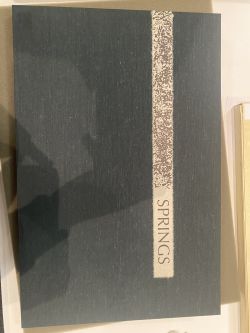Springs, An Artist Book By Enid Mark
You make italics like this.
You make bold text like this.
University of Pennsylvania's Kislak Center for Special Collections, Rare Books and Manuscripts

subsection 1
Here is how to make a footnote.[1]
subsection 1.a
subsection 2
- this
- is
- a
- bulleted
- list
subsection 3
Introduction

Springs is a limited edition artist's book created by Mark, Enid and published by the ELM Press in 1990. The book was made in Wallingford Pennsylvania, and features a series of hand-pulled lithographs printed from a combination of hand-drawn and photographic plates. This 11.5 x 36-inch book comprises of 10 pages, each page featuring a full-length image. Text is sparse, and can be found hidden within the pictures, title page, and front cover. The book is Mark's reflection of her visit to the Pollock-Krasner house. This particular copy is the second of only 25 signed copies by the author. It was acquired for the Penn Libraries with the assistance of Martin and Margy Meyerson Endowment Fund for Special Collections. Springs offers a unique creative experience, as it blends elements of Pollock's action painting with Mark's own artistic style.
Background

Author
Born in 1932, in New York City, Mark attended the High School of Music & Art in Manhattan and Smith College, where she studied English literature and studio art. In the early years of her career, she pursued painting and printmaking, and came to favor the technique of photolithography. As her career progressed, she began to gain the reputation of an adventurous bookmaker who explored many printing techniques. The texts of most of her books are works by contemporary American women poets. Each of Mark's books is devoted to a theme (such as travel, mythology, or botany). Mark selects poems that reflect that theme and develops images to complement those poems. She once wrote, “I imagine the book as a continuous picture plane on which word, image, sequence and structure all reinforce each other. What interests me most is the relationship between word and image. I plan no hierarchy of them. An artist’s book is a unique form of visual disclosure. It must be slowly savored. It should be held in the hand and carefully considered. Only then are its contents fully revealed.”
Historical Context
As seen on the credits page of the book, Mark was inspired by her visit to the Pollock-Kraser house, home to the late Jackson Pollock and his wife Lee Krasner. Jackson Pollock was an American Painter who was a leading figure of Abstract Expressionism, an art movement which began in the early 1940s, as artists sought new ways to express themselves and break away from traditional artistic styles. Best known for his unique style of drip painting, Pollock's work is characterized by his use of unconventional materials; such as using sticks, trowels, and knives to paint the canvas. He would often work at a large scale, such as using his whole body to create his paintings. This drip technique allowed Pollock to create complex layers of color and texture that were impossible to replicate with traditional brushstrokes. While he was painting, Pollock would dip his material of choice into the paint and then rapidly move his wrist, arm and body, allowing it to drip and fall into weaving lines all over the canvas. “There is no accident,” Pollock once said, “just as there is no beginning or end… Sometimes I lose a painting, but I have no fear of changes, of destroying the image, because a painting has a life of its own.”[2]
Jackson was an early pioneer in the Abstract Expressionism movement, which emerged after World War II. The movement has been interpreted differently by various generations of critics. For instance, Harold Rosenberg saw "Action Painting" (Pollock's drip technique is one example of Action Painting) as an autobiographical act of self-creation, in which artists express their anguish while paying little attention to conforming to a certain form or style of painting. This interpretation linked Abstract Expressionism with the likes of French existentialism.
Another interpretation, offered by John McCoubrey, connected Abstract Expressionism to the American tradition. He emphasized that the core of this movement was emotional honesty and naive feelings. This was an updated form of the stereotype of America at that period in time, as being a raw but vigorous country. It strayed away from the pretentiousness of previous art forms, and was perceived to be a more honest conception of American culture. [3]
Book as a Physical Object
Substrate
The pages measure 11.5 x 36 inches, and the book showcases hand-pulled lithographs created using photographic plates in blue/black and gray/green hues. The cover is composed of a cloth-covered board with a sturdy material, likely cardboard, beneath it. The book uses Rives BFK mould-made paper, renowned for its absorbent wove surface that is ideal for a variety of printmaking techniques. However, the first few pages are made of a dark gray, thin, cloth-like material, contrasting with the mould-made paper used throughout the rest of the book. This cloth-like page may have been placed between the cover and the main pages as a protective layer to prevent paint from smudging when the book is closed. Each page showcases a full-length image spanning two pages, with writings hidden within some of the pictures. The text appears to be stamped on after the lithographic painting.
-
(The front cover / title page of the book)
-
(Typical page in the book/ paper and lines on it)
-
(The back cover / last page of the book)
Format
Binding / Structure
Paratexts
Innovation
Viewership
References
- ↑ Deidre Lynch, "Paper Slips: Album, Archiving, Accident," Studies in Romanticism 57, no. 1 (2018): 87-119.
- ↑ 2.0 2.1 Jackson Pollock paintings, Bio, ideas. The Art Story. (n.d.). Retrieved May 3, 2023, from https://www.theartstory.org/artist/pollock-jackson/
- ↑ 3.0 3.1 Polcari, S. (1988). Abstract Expressionism: “New and Improved.” Art Journal, 47(3), 174–180. http://www.jstor.org/stable/777043


